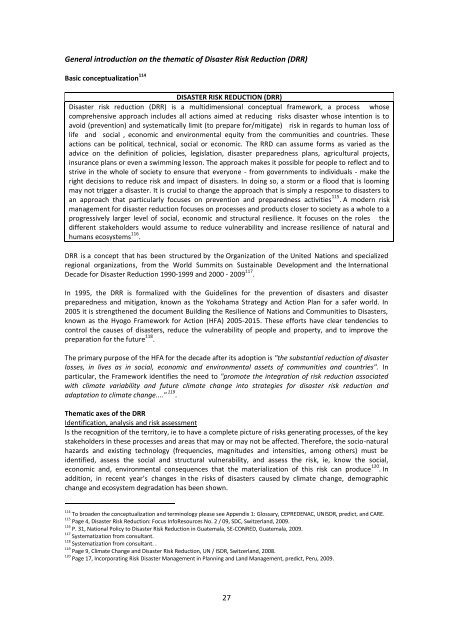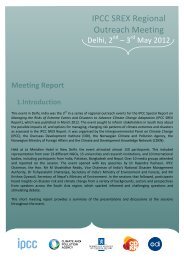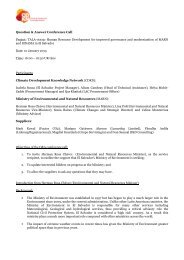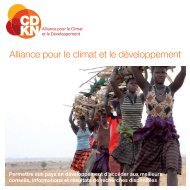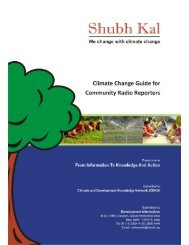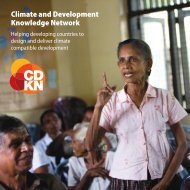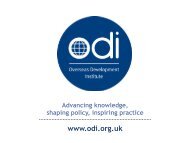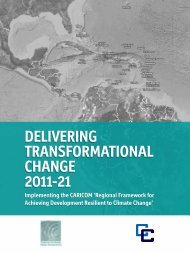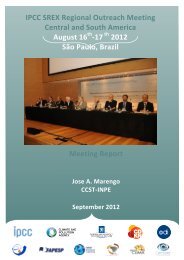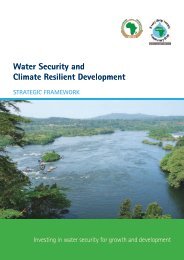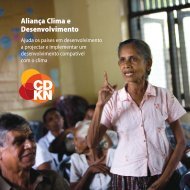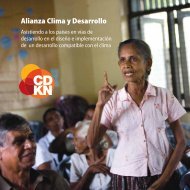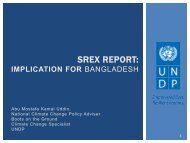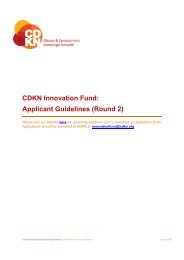Harmonized Perspectives - CDKN Global
Harmonized Perspectives - CDKN Global
Harmonized Perspectives - CDKN Global
- No tags were found...
Create successful ePaper yourself
Turn your PDF publications into a flip-book with our unique Google optimized e-Paper software.
General introduction on the thematic of Disaster Risk Reduction (DRR)Basic conceptualization 114DISASTER RISK REDUCTION (DRR)Disaster risk reduction (DRR) is a multidimensional conceptual framework, a process whosecomprehensive approach includes all actions aimed at reducing risks disaster whose intention is toavoid (prevention) and systematically limit (to prepare for/mitigate) risk in regards to human loss oflife and social , economic and environmental equity from the communities and countries. Theseactions can be political, technical, social or economic. The RRD can assume forms as varied as theadvice on the definition of policies, legislation, disaster preparedness plans, agricultural projects,insurance plans or even a swimming lesson. The approach makes it possible for people to reflect and tostrive in the whole of society to ensure that everyone - from governments to individuals - make theright decisions to reduce risk and impact of disasters. In doing so, a storm or a flood that is loomingmay not trigger a disaster. It is crucial to change the approach that is simply a response to disasters toan approach that particularly focuses on prevention and preparedness activities 115 . A modern riskmanagement for disaster reduction focuses on processes and products closer to society as a whole to aprogressively larger level of social, economic and structural resilience. It focuses on the roles thedifferent stakeholders would assume to reduce vulnerability and increase resilience of natural andhumans ecosystems 116 .DRR is a concept that has been structured by the Organization of the United Nations and specializedregional organizations, from the World Summits on Sustainable Development and the InternationalDecade for Disaster Reduction 1990-1999 and 2000 - 2009 117 .In 1995, the DRR is formalized with the Guidelines for the prevention of disasters and disasterpreparedness and mitigation, known as the Yokohama Strategy and Action Plan for a safer world. In2005 it is strengthened the document Building the Resilience of Nations and Communities to Disasters,known as the Hyogo Framework for Action (HFA) 2005-2015. These efforts have clear tendencies tocontrol the causes of disasters, reduce the vulnerability of people and property, and to improve thepreparation for the future 118 .The primary purpose of the HFA for the decade after its adoption is "the substantial reduction of disasterlosses, in lives as in social, economic and environmental assets of communities and countries". Inparticular, the Framework identifies the need to "promote the integration of risk reduction associatedwith climate variability and future climate change into strategies for disaster risk reduction andadaptation to climate change...." 119 .Thematic axes of the DRRIdentification, analysis and risk assessmentIs the recognition of the territory, ie to have a complete picture of risks generating processes, of the keystakeholders in these processes and areas that may or may not be affected. Therefore, the socio-naturalhazards and existing technology (frequencies, magnitudes and intensities, among others) must beidentified, assess the social and structural vulnerability, and assess the risk, ie, know the social,economic and, environmental consequences that the materialization of this risk can produce 120 . Inaddition, in recent year’s changes in the risks of disasters caused by climate change, demographicchange and ecosystem degradation has been shown.114 To broaden the conceptualization and terminology please see Appendix 1: Glossary, CEPREDENAC, UNISDR, predict, and CARE.115 Page 4, Disaster Risk Reduction: Focus InfoResources No. 2 / 09, SDC, Switzerland, 2009.116 P. 31, National Policy to Disaster Risk Reduction in Guatemala, SE-CONRED, Guatemala, 2009.117 Systematization from consultant.118 Systematization from consultant. .119 Page 9, Climate Change and Disaster Risk Reduction, UN / ISDR, Switzerland, 2008.120 Page 17, Incorporating Risk Disaster Management in Planning and Land Management, predict, Peru, 2009.27


